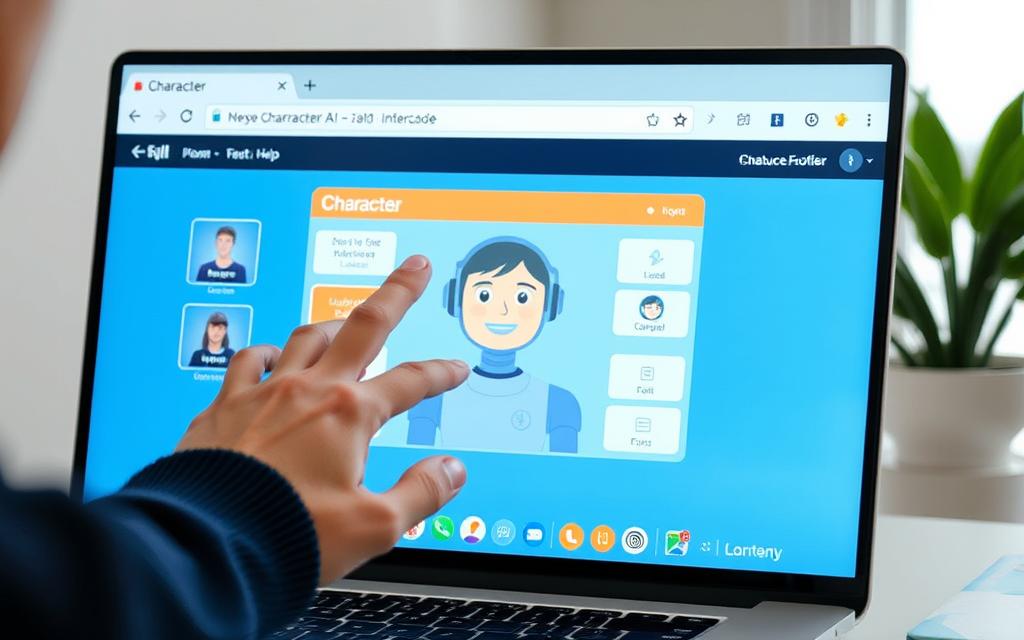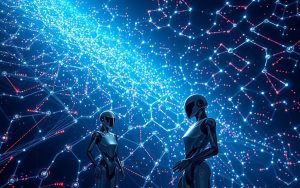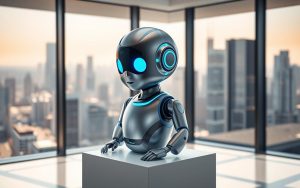Table of Contents
The development of Character.AI has been a remarkable journey, transforming from simple, rudimentary systems to sophisticated artificial intelligence that can engage in complex interactions.
In its early days, Character.AI offered a significantly different landscape from the advanced models we see today. Understanding this evolution requires exploring the historical context of character development and the key differences in capabilities and limitations compared to current systems.
This examination highlights the progress made in creating believable, interactive digital personalities using various methods and tools. By studying the past of Character.AI, we gain valuable insights into the development of artificial intelligence and its potential future innovations.
The Evolution of Character AI: From Rudimentary to Revolutionary
From rudimentary systems to sophisticated entities, Character AI’s development has been a testament to artificial intelligence progress. The early days of Character AI were marked by simple, rule-based systems that struggled to mimic human-like conversation. However, as computational power increased and algorithms became more sophisticated, so did the capabilities of Character AI.
Defining the Early Character AI Landscape
The early Character AI landscape was characterized by limited interaction capabilities and a reliance on simple pattern recognition. These systems were often based on matching user inputs to predefined responses, leading to interactions that were limited and sometimes nonsensical. Despite these limitations, early Character AI laid the groundwork for more sophisticated systems by establishing basic interaction patterns and user expectations.
- Early Character AI systems were primarily text-based, relying on user input to generate responses.
- These systems used simple algorithms to match user queries to predefined answers.
- The interactions were often stilted and lacked the nuance of human conversation.
Historical Context and Development Timeline
The development of Character AI has been influenced by advances in computing power, algorithms, and data availability. Over the years, Character AI has evolved from simple rule-based systems to complex neural networks capable of simulating human-like conversation. Key milestones in this journey include the development of more sophisticated natural language processing capabilities and the integration of machine learning techniques.
- The introduction of more advanced algorithms enabled Character AI to handle more complex user interactions.
- Increased data availability allowed for more nuanced and contextually appropriate responses.
- Advances in computational power enabled the development of more complex AI models.
Key Milestones in Character AI’s Journey
Character AI’s journey has been marked by several key milestones, including the transition from text-based interactions to more complex personality simulations. The development of video and multimedia capabilities has further enhanced the user experience, allowing for more engaging and interactive experiences. As Character AI continues to evolve, we can expect to see even more sophisticated and human-like interactions.
- The shift from text-based to multimedia interactions has significantly enhanced user engagement.
- Advances in AI have enabled more realistic and nuanced character simulations.
- The development of Character AI has been influenced by user expectations and experiences.
Technical Foundation of Old Character AI
The technical underpinnings of early Character AI systems were rooted in simplicity, laying the groundwork for future innovations. These early models relied on straightforward approaches that, while effective in certain contexts, fell short of the complexity and nuance of modern models.
Algorithms and Architecture Behind Early Models
Early Character AI often employed rule-based systems and simple statistical methods. These systems used predefined rules to determine character behavior, allowing for the creation of rudimentary interactive characters. The algorithms behind these models were primitive but innovative, utilizing techniques such as pattern matching to facilitate basic interactions.
Data Sets and Training Methodologies
The data sets used to train early Character AI models were limited, which significantly affected their capabilities. Developers employed creative solutions to maximize learning from minimal data, often relying on simple statistical methods to enhance model performance. These methodologies, although rudimentary, laid the groundwork for more sophisticated training approaches in later models.
Processing Power and Memory Constraints
Early Character AI development was significantly constrained by processing power and memory limitations. These constraints influenced design decisions, with developers optimizing tools to function within the technical limitations of their era. The result was a generation of Character AI models that were efficient, albeit limited in their capabilities.
Despite these limitations, the technical foundations established critical methodologies that continue to influence modern AI character development. The evolution of Character AI is a testament to the iterative nature of technological progress, with each generation building upon the last.
Performance and Limitations of Old Character AI
The legacy of old Character AI is characterized by the technical limitations that influenced their functionality and user experience. Older character AI systems, while groundbreaking for their time, faced significant performance limitations compared to modern counterparts.
Natural Language Processing Capabilities
Early Character AI systems struggled with nuanced understanding of human language, often lacking the ability to perceive complex sentence structures, sarcasm, or subtle emotional cues. This limitation was largely due to the nascent state of natural language processing (NLP) techniques and constraints in data availability. Despite these challenges, developers employed creative methods to enhance the NLP capabilities, thereby improving the overall user experience.
Response Time and Interaction Quality
The response time and interaction quality of old Character AI were significantly affected by technical limitations, including computational power and memory constraints. This resulted in delayed responses and sometimes irrelevant or generic interactions, impacting the interactions between users and AI characters. To mitigate these issues, developers optimized algorithms and leveraged available tools to streamline conversations.
Character Believability and User Experience
The believability of AI characters in early systems was compromised by their limited ability to understand and respond appropriately to user inputs. This affected user engagement and the overall experience. However, users often found ways to engage with these limitations, using their expertise to create meaningful interactions with the AI. A comparison of old and new Character AI systems highlights the advancements made in creating more believable characters and enhancing user interface design.
| Aspect | Old Character AI | Modern Character AI |
|---|---|---|
| NLP Capabilities | Limited understanding of complex sentences | Advanced understanding of nuanced language |
| Response Time | Often delayed | Near-instantaneous |
| Character Believability | Limited by technical constraints | Enhanced by sophisticated algorithms |
Notable Examples of Old Character AI in Action
Old Character AI systems were first seen in simple interactive games and chatbots, laying the groundwork for more complex AI implementations in later years. These early systems demonstrated rudimentary forms of persona and dialogue, often relying on predefined rules and scripts rather than deep learning to simulate character behavior.
Early Text-Based Adventure Games and Chatbots
Early text-based adventure games, such as Zork from the late 1970s and early 1980s, simulated simple character interactions via text-based commands. Characters in these games had limited personalities, often based on predefined responses to player input. These games focused on narrative and problem-solving, with limited character agency. The text-based interface allowed users to interact with the game world using commands, creating a basic form of conversation.
- Text-based adventure games like Zork pioneered the use of character AI in gaming.
- Chatbots like ELIZA demonstrated early forms of conversation simulation.
- These early systems laid the foundation for more advanced character AI.
Character AI in Gaming and Simulations
In early gaming environments and simulations, Character AI was used to create more immersive experiences. Games used character AI to control non-player characters (NPCs), making the game world feel more dynamic. The technical approaches varied, with some games using complex decision trees and others relying on simple state machines.
Case Studies: Successes and Failures
Several case studies highlight the successes and failures of old Character AI implementations. For instance, the chatbot ELIZA was successful in simulating conversations, making users believe they were interacting with a human. On the other hand, some character AI implementations in games were criticized for their limited and predictable behavior. Analyzing these case studies provides valuable insights into the challenges and opportunities of character AI development.
By examining these early examples, we can understand how character AI has evolved over time and how different methods of character implementation affected the overall quality and believability of AI personalities.
Impact on Storytelling and Creative Media
Older character AI systems, despite their limitations, have had a lasting impact on the development of narrative design in creative media. The constraints of early character AI technology forced developers to be innovative in their storytelling approaches, leading to unique narrative experiences that continue to influence the industry today.
Shaping Narrative Design
Old character AI significantly influenced narrative design by limiting the complexity of character responses, which in turn forced developers to prioritize specific story beats and character arcs. This led to the creation of more focused narratives where every character interaction contributed to the overall story. As a result, narrative designers developed creative methods to craft compelling stories within the technical constraints of the time.
Creative Workarounds for Technical Limitations
Developers implemented various creative workarounds to overcome the limitations of older character AI. For instance, they used pre-defined dialogue trees and carefully crafted character interactions to create the illusion of more sophisticated AI capabilities. These workarounds not only enhanced the user experience but also contributed to the development of more engaging narratives.
Influence on Modern Interactive Storytelling
The legacy of older character AI can be seen in modern interactive storytelling, where current approaches both build upon and react against earlier limitations. Modern narrative design continues to evolve, incorporating lessons learned from the past to create more immersive and engaging experiences. The influence of older character AI is evident in the design of interactive stories, where character development and user engagement are paramount.
The impact of older character AI on storytelling and creative media is a testament to the industry’s ability to adapt and innovate in the face of technical constraints. As character AI technology continues to advance, it will be interesting to see how narrative design evolves in response to new capabilities and challenges.
Accessing the Old Character AI Interface

Users looking to access the older Character AI interface will find that it’s easier than they think. The platform, known for its AI-driven characters and conversations, introduced a new interface that left some users longing for the familiar look and feel of the original.
Step-by-Step Guide to URL Modification Method
One way to access the old Character AI interface is by modifying the URL. This method allows users to switch back to the previous version through their web browser. To do this, users need to make a small adjustment to the website’s URL, which will enable them to enjoy the familiar layout they prefer.
The process involves understanding the URL structure and making the necessary changes to access the older version. By following these steps, users can easily revert to the previous interface.
Downloading Older Versions for Android Devices
For Android users, another option is to download older versions of Character AI from Uptodown. This method is particularly useful if the latest Character AI version is not supported by the device or contains bugs. Users should be aware of the compatibility considerations and potential issues associated with using older versions.
Downloading older versions can provide a workaround for users experiencing compatibility issues or those who prefer the older interface.
Limitations and Considerations When Using Old Versions
While accessing older versions of Character AI can be beneficial, there are several limitations and considerations to be aware of. These include potential security risks, missing features, and compatibility issues. Users should weigh these factors before deciding to use an older version.
It’s also important to consider how platform updates have affected the availability and functionality of older Character AI interfaces over time. Understanding these aspects will help users make informed decisions about their usage.
Alternatives to Old Character AI for Different Needs
As Character AI continues to evolve, users are seeking alternative platforms that offer more flexibility and creative freedom. The emergence of alternative platforms demonstrates the growing demand for unrestricted AI interaction.
Platforms with Fewer Content Restrictions
For users seeking AI character interactions without content restrictions, several alternative platforms exist. Crushon.AI allows unfiltered conversations and lets you create your own characters.
Similarly, Janitor AI offers the option to disable the NSFW filter, providing more flexibility in character interactions.
Another platform, Tavern AI, focuses on text-based AI bots with less emphasis on filtering, catering to users who prefer more open-ended interactions.
AI Characters with Enhanced Creative Capabilities
Some platforms offer enhanced creative capabilities compared to old Character AI. For instance, certain alternatives provide advanced tools for character creation and customization. To explore more options, visit our guide on best Character AI alternatives. These platforms allow users to craft unique characters and engage in more sophisticated interactions.
Choosing the Right Platform Based on Your Needs
When selecting an alternative to Character AI, consider your specific needs and preferences. Evaluate the features and content policies of different platforms to determine which one best suits your use case. Factors such as updates and version changes should also be considered to ensure the platform’s stability and evolution align with your requirements.
Conclusion: Valuable Lessons from Character AI’s Legacy
Character AI’s legacy offers a wealth of knowledge and insights that can inform future developments in artificial intelligence. By examining the history and development of Character AI, we can gain a deeper understanding of the field’s progress and challenges.
The limitations of early Character AI systems drove innovation and creative problem-solving, influencing modern AI development. Enduring principles of character design and interaction have remained relevant despite technological advancements.
Understanding Character AI’s legacy provides valuable expertise for anticipating future developments in artificial intelligence and character interaction. User preferences and experiences with different versions of Character AI reveal important insights about human-AI interactions.
The evolution of Character AI methods reflects broader trends in technology development and user experience design. Social media and community engagement have shaped the development and reception of Character AI systems over time.
Preserving access to older tools and methods is crucial, as they offer unique value to different users. By learning from Character AI’s legacy, we can inform future developments in the field and create more sophisticated character interactions.
FAQ
What are the primary differences between the early Character AI models and the current versions?
The primary differences lie in the advancements in algorithms, data sets, and processing power. Current versions offer more sophisticated natural language processing capabilities and improved interaction quality.
How did the early Character AI systems handle user interactions?
Early Character AI systems used simpler algorithms and were limited by processing power and memory constraints, resulting in less believable character interactions and more restricted conversations.
Are there any alternatives to using the older Character AI versions?
Yes, there are platforms that offer fewer content restrictions and AI characters with enhanced creative capabilities. The choice of platform depends on specific needs and requirements.
Can I still access the old interface of Character AI?
Accessing the old interface may be possible through URL modification or by downloading older versions for Android devices. However, this comes with certain limitations and considerations regarding security and updates.
How did Character AI influence modern interactive storytelling?
Character AI played a significant role in shaping narrative design and creative workarounds for technical limitations, ultimately influencing the development of modern interactive media and storytelling methods.
What were some of the key milestones in Character AI’s development journey?
Key milestones include advancements in algorithms, improvements in data sets and training methodologies, and significant increases in processing power, all contributing to more sophisticated AI functionalities.
What are the security considerations when using older versions of Character AI?
Using older versions may expose users to security risks due to a lack of updates and potentially unpatched vulnerabilities. It’s essential to weigh these risks against the benefits of using older versions.









